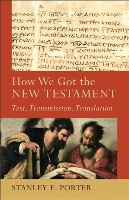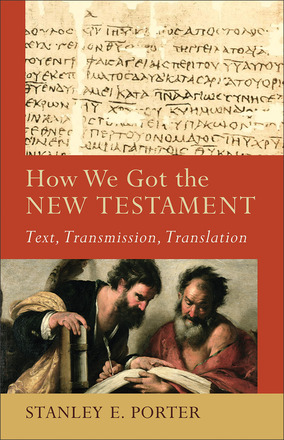Stanley Porter (PhD, University of Sheffield) is president, dean, and professor of New Testament at McMaster Divinity College in Hamilton, Ontario. He is well known for his work in New Testament studies, and so we were interested to see his new work How We Got the New Testament: Text, Transmission, Translation. We asked him to address a few questions that are of increasing interest in our day.
Books At a Glance (Fred Zaspel):
First, just on a personal level, what led you to begin studying the New Testament academically? Can you tell us something of your background?
Porter:
I had completed a BA and MA in English and literature, and was about to begin a PhD in English when I had what I sometimes refer to as a second “conversion” experience. I was converted away from studying English and a teaching career in English literature and toward going to seminary and doing a PhD in New Testament. I had already been a Christian for quite some time and knew I wanted to end up as a teacher in a college or university (I come from a family of educators), but through a series of events that took place in less than a week God impressed upon me that I was to leave the study of English and go to seminary–even though I really did not understand what it meant to go to seminary. I had providentially taken an intensive summer Greek course at a seminary before doing my MA in English, but being an outsider at the seminary meant that I did not really understand the seminary environment. Nevertheless, it was already August when I visited several seminaries, but then applied and decided sight-unseen to attend seminary in Chicago (TEDS). So, after being accepted, I packed my car and drove two thousand miles to Chicago to do a MA in New Testament. That then led to a PhD in Biblical Studies and Linguistics and to my career as an academic theologian and New Testament scholar.
Books At a Glance:
What is textual criticism? And what is the goal of the endeavor?
Porter:
Textual criticism is an intriguing and increasingly complex discipline that, traditionally, tries to establish the best text in a given situation or context. For New Testament studies, this has usually meant trying to establish the closest text to the one that originated with the author–what I refer to as the published text of the author. Recently, however, there have been a number of textual critics and others who have argued that we should be more concerned with trying to find the earliest recoverable text. I can sympathize to some extent with the difficulty of the task and the desire, perhaps, to find a more manageable goal, but even such a modified aim is predicated upon being able to differentiate earlier from later readings, and so I think that the traditional goal remains our desired objective. However, we also must recognize that with either goal, including the traditional one as currently practiced, we end up with producing an eclectic text that selects various readings from the available manuscripts, and does not match any extant early manuscript.
 Books At a Glance:
Books At a Glance:
For those who are new to the discussion, can you explain briefly the debate regarding the various manuscripts, manuscript families, and the claimed value of one over the others?
Porter:
In a nutshell, this debate revolves around determining which manuscripts are the ones we should use for establishing the Greek text of the New Testament. Since Erasmus in the sixteenth century until the late nineteenth century, the so-called Textus Receptus was the basis of our Greek New Testament. This text was based upon a relatively small number of later manuscripts (roughly tenth to twelfth century or so). The majority of our manuscripts are close to the text found in the Textus Receptus, but they are also generally later manuscripts. With the identification and discovery of earlier manuscripts–and that they can be grouped together in various families–a shift occurred in textual criticism. Though some still argue for the majority text (found in the majority of the total manuscripts, with most of them being late) or Byzantine text (the one found in the Byzantine manuscript tradition), both similar to the Textus Receptus, most textual critics believe that we should follow the earlier manuscripts that are often identified with what is called the Alexandrian family of manuscripts. The Alexandrian family is the oldest of the identifiable manuscript families. The two major manuscripts here are Codex Sinaiticus and Codex Vaticanus. I have suggested that we perhaps ought to use Codex Sinaiticus as not just one of our major sources or as a basis of other texts but as the text itself of the Greek New Testament that we use for reading and study–recognizing that it is not the original text but is the earliest complete manuscript of the Greek New Testament, and a manuscript actually used by the early Church. This does not eliminate the need for textual criticism and reconstruction, but it does focus upon a text with ancient integrity and authority.
Books At a Glance:
Explain for us how the topic of your book, How We Got the New Testament, is important for non-specialists. How are these questions affecting or becoming important for Christians, both pastors and laymen, today?
Porter:
I want to make clear that, although my book does deal with some issues of contemporary apologetics, including some issues controverted in the popular press, my book, How We Got the New Testament, is not designed primarily as an exercise in apologetics. I hope that it may help some people understand the basis of the text, transmission, and translation of the Greek New Testament, but I take a different approach than popular apologetics. Rather than addressing contemporary apologetic issues, I address what I consider to be major and significant issues in the history and development of early Christianity, and propose what I think is the most reasonable way of explaining how we got what we have. That is, I examine the textual basis of our Greek New Testament, reconstruct the history of its transmission from earliest times, and then trace the history of its translation. The overall result is an overwhelming affirmation of the reliability of the Greek New Testament that we currently use, even though it is a reconstructed product, but more than that, the presentation of a plausible account of the various strands of evidence. I hope that this has direct value for anyone interested in the New Testament, both pastors and lay people, and especially for those interested in some of the more technical aspects of its text.
Books At a Glance:
Why do you think there is such a flurry of interest in revisionist accounts of the New Testament and related issues (Bart Ehrman, The Da Vinci Code, Gospel of Thomas, etc.)? And are these issues new?
Porter:
I am not sure that there is any greater flurry of interest in revisionist thinking now than there has been in the past–there has been this kind of thinking off and on for at least the last hundred or more years. I have a book in my library that was published over a hundred years ago and written by a well-known New Testament scholar of the time, and it deals with many of the same issues raised by our contemporary sensationalizers. I think that the flurry may appear to be greater because of mass media and publishers, even evangelical ones, wishing to take advantage of a wave of interest to sell more books. I think that it may also be the result of churches failing to do a good enough job in teaching the Bible adequately so that their people have confidence not just in the technical aspects of the Bible, but in the God who inspired the Bible. I think that if one’s theology is in adequate shape, most of these other issues become relatively less important and certainly less enticing and persuasive.
Books At a Glance:
The Bottom line of all this, of course, is whether a Christian can have confidence that our New Testament is a faithful transmission of what the apostles of Christ actually wrote. Is there a brief answer to this question?
Porter:
Yes, one definitely can. Is that a brief enough answer? I have tried to present what I think is a reasonable, plausible, and defensible reconstruction of the transmission of the New Testament, and I think that we can trace at least the Gospels and Acts and Paul’s letters back to the earliest days of Christianity, including Paul’s letters back to Paul himself because I think he was the gatherer of his own letter collection. The Gospels similarly can be traced back to the early second century if not before. The rest of the New Testament does not have the same level of evidence, but I see no major reason to doubt its transmissional fidelity.
Books At a Glance:
You address the question of translation in your book also, a topic of on-going debate and discussion. Perhaps you could offer some general considerations that would be helpful for us. What should we look for in a Bible translation? What factors should guide us in the decision?
Porter:
Translation may appear at first sight to be the odd issue out in the discussion of the text, transmission, and translation of the New Testament. However, most Christians deal with their Bible in translation, and so I think that it is a very important topic. Right now, I think that there is an unhelpful tendency to try to determine what is the best translation. The question, I think, is not what is the best translation, but what is the most useful translation for a particular context. We have the luxury in the western world, and especially in the English-speaking world, of being able to choose from many translations. Some are probably better for public reading, others for private study, some for use with Greek or Hebrew, and the like. We have to remember that the translation, as well done and faithfully made as it might be, is not the original text, and so is a product of interpretation by either an individual or various individuals on a committee. What I think that we need more of is movement away from the simplistic debate over literal or dynamic translation and consideration of larger issues in translation that recent linguistic investigation has brought to bear. I look forward to the possibility of a new generation of translations that move well beyond the sentence (usually the maximal unit for most translations) and consider the variety of discourse factors and the various levels of language use and how these are rendered.
Books At a Glance:
Finally, perhaps you could give a word of encouragement to theological students concerning the study of Greek. Why is this study important for them, and in what ways will it pay off for them in the long run?
Porter:
I know that it is a commonplace to condemn seminaries and colleges for decreasing their language requirements in Greek. I share that concern. However, I also think that seminaries and colleges should also be concerned that they are not only decreasing requirements but dumbing down the study of Greek by using teaching tools that do not provide adequate preparation for students who really want to learn the Greek language. I think that such tools themselves can end up being counterproductive, because it gives students a false impression of how much they actually know–or don’t know. I find it odd that theological students would even consider a theological education that did not include rigorous study of Greek as part of the curriculum. By rigorous study, I do not mean the continued use of out-moded and out-dated teaching tools or more advanced Greek language tools (which is, unfortunately, the case in most places), but availing ourselves of the advances made through Greek linguistics as part of the wider field of linguistic study. I am disappointed that there has been resistance to such advances, and exaltation of works that were written in the nineteenth and early twentieth centuries, as if these tools are adequate for today. Modern linguistic study–and its appreciation for the systematic nature of language, among other things–offers new avenues for thinking about Greek that help us to have a more informed understanding of the nature of language and communication, including how God communicated through the Greek New Testament. I think that this is worth our best efforts. The results can be incredible–not just the ability to translate a passage, but ability to understand how a passage works, and hence how and what it communicates. This understanding can provide endless teaching and preaching material.
Buy the books

How We Got The New Testament: Text, Transmission, Translation
